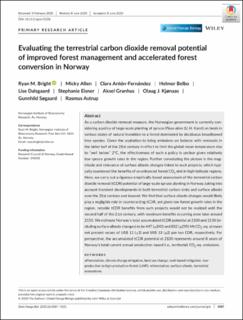| dc.contributor.author | Bright, Ryan M. | |
| dc.contributor.author | Allen, Micky | |
| dc.contributor.author | Antón-Fernández, Clara | |
| dc.contributor.author | Belbo, Helmer | |
| dc.contributor.author | Dalsgaard, Lise | |
| dc.contributor.author | Eisner, Stephanie | |
| dc.contributor.author | Granhus, Aksel | |
| dc.contributor.author | Kjønaas, O. Janne | |
| dc.contributor.author | Søgaard, Gunnhild | |
| dc.contributor.author | Astrup, Rasmus Andreas | |
| dc.date.accessioned | 2020-11-24T08:46:19Z | |
| dc.date.available | 2020-11-24T08:46:19Z | |
| dc.date.created | 2020-10-12T22:39:17Z | |
| dc.date.issued | 2020-06-19 | |
| dc.identifier.citation | Global Change Biology. 2020, 26 (9), 5087-5105. | en_US |
| dc.identifier.issn | 1354-1013 | |
| dc.identifier.uri | https://hdl.handle.net/11250/2689226 | |
| dc.description.abstract | As a carbon dioxide removal measure, the Norwegian government is currently considering a policy of large-scale planting of spruce (Picea abies (L) H. Karst) on lands in various states of natural transition to a forest dominated by deciduous broadleaved tree species. Given the aspiration to bring emissions on balance with removals in the latter half of the 21st century in effort to limit the global mean temperature rise to “well below” 2°C, the effectiveness of such a policy is unclear given relatively low spruce growth rates in the region. Further convoluting the picture is the magnitude and relevance of surface albedo changes linked to such projects, which typically counteract the benefits of an enhanced forest CO2 sink in high-latitude regions. Here, we carry out a rigorous empirically based assessment of the terrestrial carbon dioxide removal (tCDR) potential of large-scale spruce planting in Norway, taking into account transient developments in both terrestrial carbon sinks and surface albedo over the 21st century and beyond. We find that surface albedo changes would likely play a negligible role in counteracting tCDR, yet given low forest growth rates in the region, notable tCDR benefits from such projects would not be realized until the second half of the 21st century, with maximum benefits occurring even later around 2150. We estimate Norway's total accumulated tCDR potential at 2100 and 2150 (including surface albedo changes) to be 447 (±240) and 852 (±295) Mt CO2-eq. at mean net present values of US$ 12 (±3) and US$ 13 (±2) per ton CDR, respectively. For perspective, the accumulated tCDR potential at 2100 represents around 8 years of Norway's total current annual production-based (i.e., territorial) CO2-eq. emissions. | en_US |
| dc.language.iso | eng | en_US |
| dc.publisher | John Wiley & Sons Ltd. | en_US |
| dc.rights | Navngivelse 4.0 Internasjonal | * |
| dc.rights.uri | http://creativecommons.org/licenses/by/4.0/deed.no | * |
| dc.title | Evaluating the terrestrial carbon dioxide removal potential of improved forest management and accelerated forest conversion in Norway | en_US |
| dc.type | Peer reviewed | en_US |
| dc.type | Journal article | en_US |
| dc.description.version | publishedVersion | en_US |
| dc.rights.holder | © 2020 The Authors | en_US |
| dc.source.pagenumber | 5087-5105 | en_US |
| dc.source.volume | 26 | en_US |
| dc.source.journal | Global Change Biology | en_US |
| dc.source.issue | 9 | en_US |
| dc.identifier.doi | 10.1111/gcb.15228 | |
| dc.identifier.cristin | 1839026 | |
| dc.relation.project | Norges forskningsråd: 194051 | en_US |
| cristin.ispublished | true | |
| cristin.fulltext | original | |
| cristin.qualitycode | 2 | |

